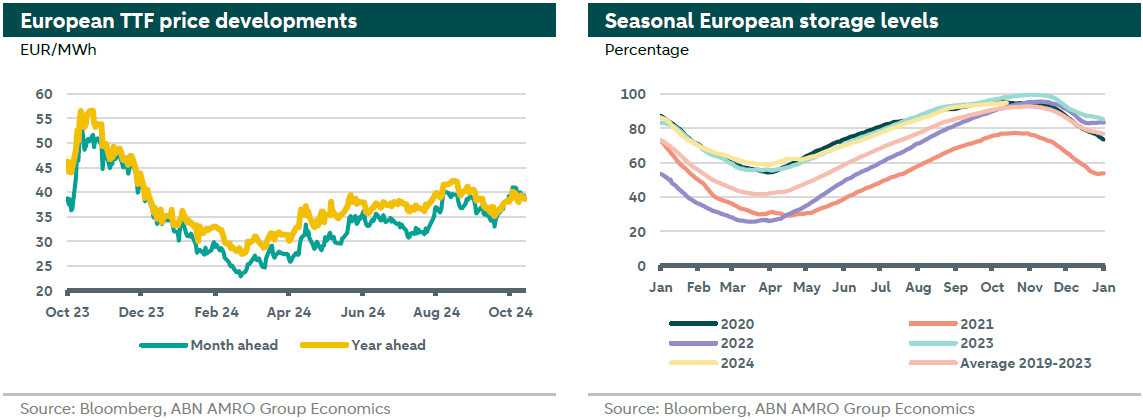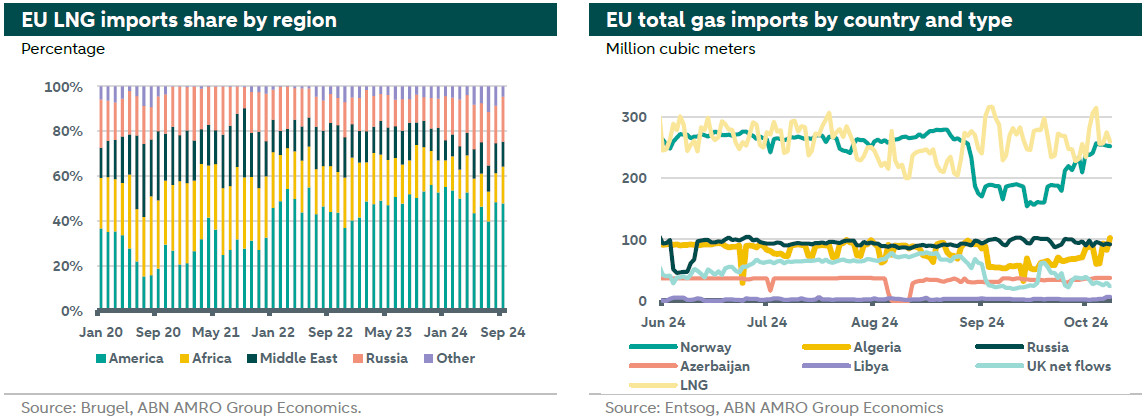Gas market strategist - Winter is here, is the market ready?

Since mid-August, the upward trend in European gas price reversed temporarily, however it has regained some momentum since mid-September. The TTF has averaged 38.7 €/MWh for the benchmark year-ahead contract in the past two months (37.5 €/MWh for the month-ahead contract). Volatility in prices in this period was fueled by weather conditions (cold spell in Europe), the hurricane season in the US, the upcoming end of the Ukrainian gas transit agreement with Russia, and geopolitical tensions, especially in the Middle East. At the same time, the above-average storage levels has helped to put a lid on prices. As we enter the heating season, European industrial demand continues to be weak, while LNG markets remain tight, and volatility is here to stay.
Recent volatility in European TTF prices was fueled by weather conditions, the upcoming end of the Ukrainian gas transit agreement with Russia, and geopolitical tensions in the Middle East
European gas storage levels are at 95%, providing a strong buffer as we enter the heating season
Demand for heating purposes will be the leading driver in the coming months as a clear improvement in the industrial sector looks unlikely before the turn of the year
Markets are vigilant to emerging uncertainties from unplanned outages/maintenance in main suppliers such as Norway or the US, or a wider conflict in the Middle East
We expect the benchmark year-ahead contract to average around 40 €/MWh in Q4, which is close to current levels

European gas market drivers
Europe was successful in reaching its strategic storage goal (90% full by November) almost two months in advance. Storage levels are currently at 95% (see right hand chart above). This has given the market some relief, but other factors have invoked uncertainty in the market inducing volatility in prices.
For a start, TTF market participants have been very vigilant to any news regarding the extension of the transit agreement of Russian gas through Ukraine, which expires by the end of December. There are still several European countries like Austria and Slovakia that rely heavily on the Russian gas coming through Ukraine. Ukrainian authorities denied any intention to extend the agreement with Russia given the war between the two continues following Russia’s invasion. The most probable solution is to substitute Russian gas with that coming from Azerbaijan through Ukraine. However, markets remain cautious as no agreement has been reached yet. If no agreement is reached, the Russian pipeline supply would need to be compensated by higher supply from other sources such as Norwegian pipeline gas or higher LNG imports from the USA.
As has been case with energy markets more broadly, LNG markets have been responsive to the resurgence of tensions in the Middle-East. Especially following the latest Iranian attack by missiles and drones on Israel and the Israel’s statement that it would retaliate. LNG markets are particularly concerned by potential supply disruptions from a wider conflict affecting LNG coming from the region. EU LNG imports come mainly from America (USA and Trinidad & Tobago, with an average share of 49% in 2024), followed by Russia (19% share), Africa (Algeria, Angola, Nigeria, Egypt, Cameroon and Equatorial Guinea, with a share of 14%), the Middle-East (Qatar, Oman and United Arab Emirates, with a share of 11%), and other countries (7% average share in 2024), respectively, as shown in the chart below (left). Even though most of European LNG imports comes from the USA, supply disruptions in the Middle East would increase international competition of the fuel and increase European prices.

Imports from Norway, the main pipeline supplier, have regained their normal levels after a period of low flows in September and early October following an extended maintenance schedule. Similarly for imports coming from Algeria, as can be seen in the chart above (right). Accordingly, LNG would be the main source of volatility in the coming months as long as no new disruptions in the pipeline supply would emerge.
From the demand side, the European industrial sector remains in the doldrums. The eurozone is still an underperformer with the manufacturing PMI down at 45 in September – with Germany’s PMI falling back to a ten-month low of 40.6, while the French PMI is also at low levels (44.6). Forward looking indicators also remain depressed. Accordingly, a recovery in industrial gas demand is not expected before the turn of the year.
Weather forecasters are predicting that the coming winter will be colder than the average of the last 10 years, which would increase the demand for heating purposes. At the same time, the increase in renewable capacity and output in the past two years reduces the gas demand for power generation below seasonal averages, though it made it more sensitive to weather conditions affecting renewable generation. According to BloombergNEF, Europe is expected to end the winter with 35% storage full, assuming a colder than normal weather.
The geopolitical premium on TTF price is back following the resurgence of escalation between Iran and Israel after the assassination of Hezbollah leader in Lebanon by Israel, followed by a missiles attack by Iran. Israel vowed to retaliate, increasing the likelihood of further escalation. Under such scenario, Israel’s gas exports could be halted and LNG exports from Qatar could be adversely affected, especially if trade through the strait of Hormuz is disrupted, which would increase competition in the global LNG markets putting upward pressure on TTF price. More recently the risk premium in energy markets has eased following reports that Israel would not target Iran’s energy infrastructure in any attack.
Outlook
Looking forward, with the current storage levels (95%), Europe is entering the winter with a strong buffer at hand. This delivers some relief to the market and reduces price volatility in response to short-term shocks, such as cold spells or lower renewable output. Furthermore, demand for heating purposes will be the leading component for the fuel in the coming months as demand for industrial purposes will likely remain weak. However, emerging uncertainty following long-term supply disruptions, such as unplanned outages/maintenance in Norway and the USA, or in main LNG suppliers such as Australia, or a wider conflict in the Middle East are upside risks to prices. In addition, we expect the new transit agreement through Ukraine to be reached soon, which would put a downward pressure on prices. Accordingly, our outlook for TTF year-ahead price is to average around 40 €/MWh (36 €/MWh for the month-ahead price) in Q4 of 2024.
